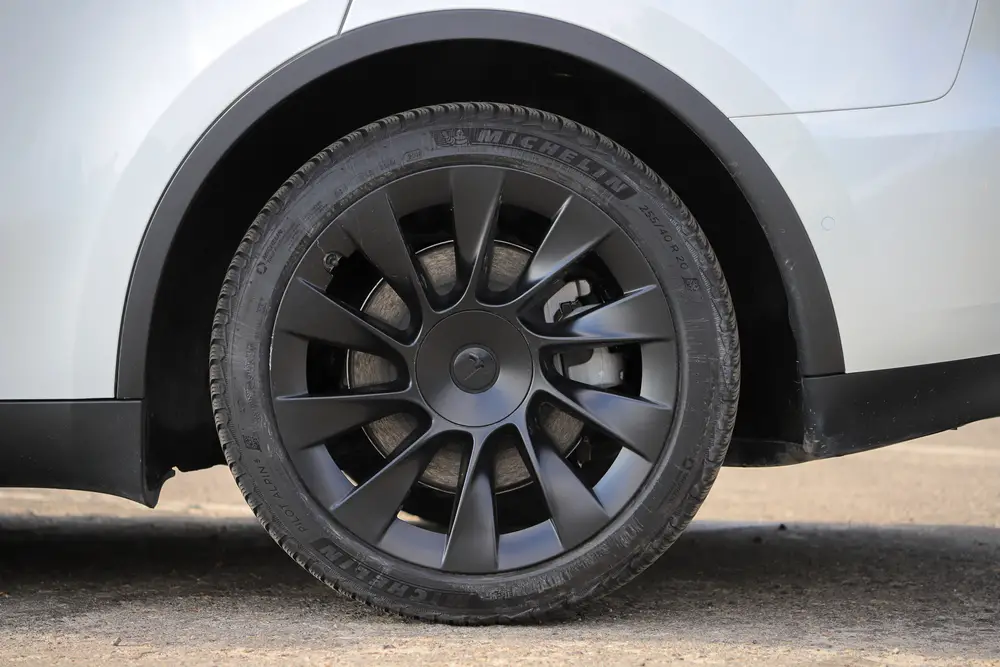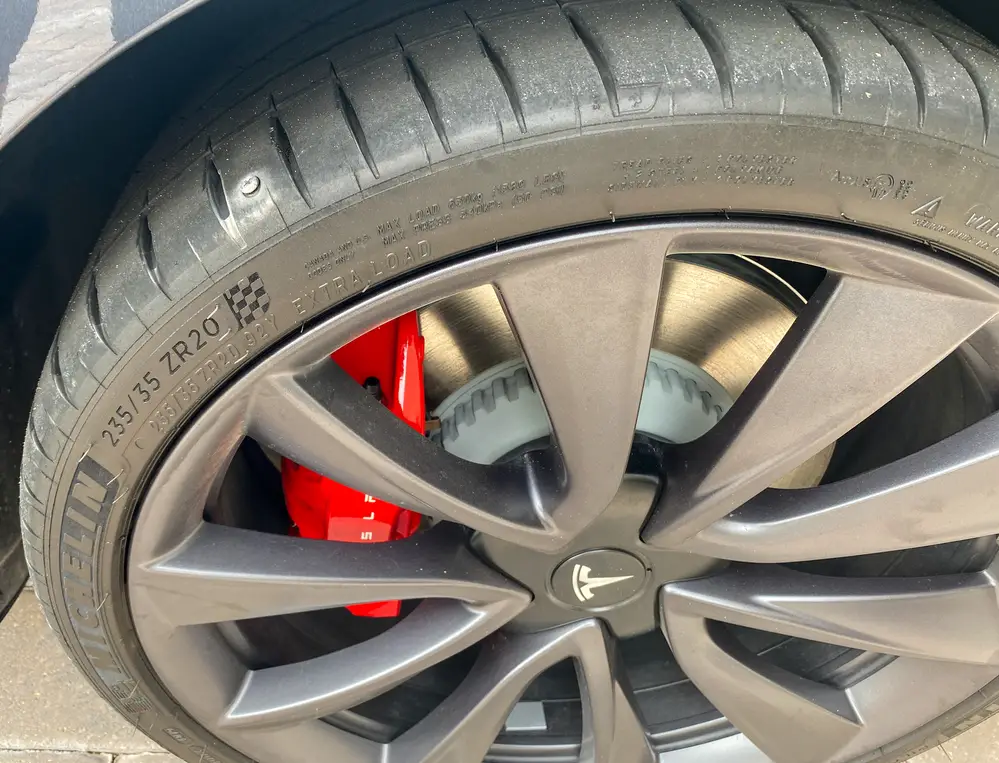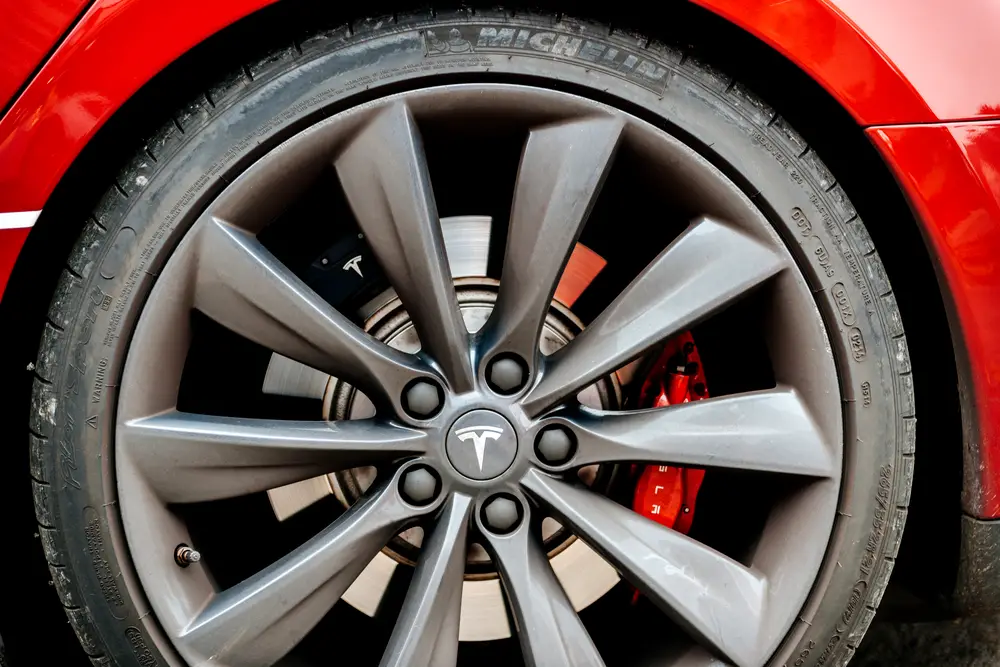As with any vehicle, Tesla owners may wonder about the longevity of various components, including the tires.
A common question that arises is whether Tesla tires wear out faster compared to those on traditional gasoline-powered vehicles.
Quick Answer:
Tesla tires may wear out faster due to factors like the vehicle’s increased weight from battery packs, powerful torque, and driving habits like rapid acceleration. Regular maintenance can mitigate wear, but tires might still wear more quickly.
Armed with this knowledge, Tesla owners and potential buyers can better understand what factors contribute to tire wear on their electric vehicles and make informed decisions regarding maintenance and driving habits.
Performance Factors Affecting Tesla Tire Wear
Weight and Acceleration
Tesla cars, like other electric vehicles (EVs), carry large battery packs that add extra weight to the vehicle. This extra weight means that the tires have to support more mass, which can lead to increased wear.
Furthermore, Tesla cars are known for their impressive acceleration capabilities. Rapid acceleration puts added stress on the tires, causing them to wear more quickly.
Torque and Electric Motors
Electric cars, including Teslas, produce instant torque directly from their electric motors. This torque allows for fast acceleration but also puts more stress on the tires.
The higher torque generated by the electric motors can lead to increased tire wear, especially if the tires are not properly maintained or suited for the vehicle’s power output.
Regenerative Braking
Regenerative braking is a feature in Tesla and other EVs that recovers energy during deceleration and feeds it back into the battery pack.
While this helps extend the range of the vehicle, it also leads to additional tire wear. The reason for this is that regenerative braking can cause more abrupt deceleration, which puts additional stress on the tires.
Driving Habits
Lastly, driving habits play a significant role in the rate at which Tesla tires wear out. Aggressive driving, such as rapid acceleration, hard braking, and fast cornering, will cause tires to wear out more quickly. Conversely, adopting a more conservative driving style can help extend the life of the tires.
Drivers who are mindful of their habits and maintain their vehicles properly can help counterbalance some of the tire wear that comes with driving a high-performance Tesla car.
Tire Maintenance and Rotation
Tire Rotation Importance and Schedule
Tire rotation is crucial for maintaining the longevity of your Tesla tires. Regularly rotating the tires helps distribute wear evenly across all four tires, improving their lifespan and performance.
Tesla recommends rotating your tires every 10,000 to 12,000 miles or as needed based on inspection results.
- Front tires experience more wear due to braking and steering forces
- Rear tires may wear faster in Tesla’s performance models due to aggressive acceleration
Sticking to a consistent rotation schedule can reduce uneven wear and extend the life of your tires.
Alignment and Balancing
Proper wheel alignment and balancing are essential for maintaining even tire wear and ensuring a smooth, comfortable ride. Misaligned or unbalanced wheels can cause:
- Rapid or uneven tire wear
- Vibration or pulling while driving
- Decreased fuel efficiency
To keep your Tesla tires in optimal condition, have your alignment checked and your wheels balanced at least once a year or as recommended by Tesla’s service schedule.
Tire Pressure Management
Maintaining the proper tire pressure is crucial for ensuring optimal performance, handling, and safety on the road.
Check your Tesla’s recommended tire pressure in the owner’s manual or on the driver’s side door jamb sticker.
- Underinflated tires can cause increased rolling resistance, leading to reduced fuel efficiency
- Overinflated tires might wear unevenly and have a harsher ride
- Fluctuating temperatures can affect tire pressure, so check it regularly, especially during seasonal changes
Ensure that you maintain the recommended tire pressure for your Tesla to enhance the tire’s lifespan and the overall driving experience.
Exploring Tesla Tire Alternatives
Michelin Primacy MXM4
The Michelin Primacy MXM4 is a popular alternative for Tesla owners seeking a high-quality tire that provides exceptional comfort and handling. These tires are designed to offer improved longevity, with a manufacturer claim of up to 55,000 miles of wear.
Goodyear All-season Tires
Goodyear offers several all-season tire options suitable for Teslas, such as the Assurance WeatherReady or the Eagle Sport All-Season. These tires are designed to perform well in various weather conditions and boast long-lasting wear.
Goodyear’s all-season tires provide a comfortable ride and responsive handling, making them an attractive option to consider for your Tesla.
Winter Tire Options
If you live in an area with harsh winter conditions, it’s essential to invest in a set of winter tires for your Tesla. Winter tires are specifically designed to handle well on ice and snow, offering increased traction and safety.
Top winter tire options for Tesla vehicles include the Michelin X-Ice Xi3 and Goodyear Ultragrip Ice. These tires perform exceptionally well in cold temperatures, providing enhanced grip and control.
Tesla Tire Characteristics and Lifespan
Comparing with Traditional Gas-Powered Cars
Tesla vehicles, being electric and often heavier than their gas-powered counterparts, can experience relatively faster tire wear. The instant torque from electric motors may lead to increased strain on the tires, resulting in quicker wear.
However, it is essential to note that tire lifespan varies depending on several factors, such as driving habits, tire type, and proper maintenance.
Model S, 3, X, and Y Tire Differences
Each Tesla model comes with specific tire options and sizes that influence its lifespan:
- Tesla Model S: The Model S, being the flagship sedan, is equipped with high-performance tires designed for excellent grip and handling. Due to their soft rubber compound, these tires may wear out faster, especially when frequently driving in a spirited manner. Upgrading to an all-season or touring tire can result in a longer tire lifespan.
- Tesla Model 3: The Model 3 is available with various tire options, from standard all-season tires to high-performance tires. All-season tires on the Model 3 tend to have a relatively longer lifespan compared to the performance variant. Regular tire rotation and proper inflation are crucial to maximizing tire longevity.
- Tesla Model X: As a heavier SUV, the Model X requires tires designed to support its weight and provide sufficient grip. The tire wear on the Model X is generally more rapid due to its heavier curb weight and larger contact patch. It is recommended to rotate the tires regularly and maintain correct air pressure to extend their lifespan.
- Tesla Model Y: The Model Y, being a smaller crossover, shares some tire options with the Model 3. Similar to the Model 3, owners can expect a relatively longer tire lifespan from all-season tires compared to performance tires. Regular tire maintenance, including rotation and inflation, is vital for prolonging tire life.
Common Road Hazards and Conditions
Potholes and Rough Roads
Potholes and rough roads can significantly affect the wear of Tesla tires. Continuous exposure to such road conditions may lead to uneven wearing of the tire tread, with rear tires receiving more damage.
This uneven wearing can impact the vehicle’s handling capabilities, potentially resulting in a safety issue. Frequent driving on rough roads may also necessitate more frequent roadside assistance or expensive tire replacements.
Impact of Heavy Expressive Driving
Heavy expressive driving, such as sudden acceleration and aggressive braking, can also contribute to the accelerated wearing of Tesla tires.
Rapid starts and stops can lead to more strain on the tires, increasing the risk of a flat tire or other damage, as well as affecting overall wearing out.
Effect on Lifespan and Safety
The impact of road conditions and driving habits on Tesla tires can result in varying tire lifespans. A combination of potholes, rough roads, and heavy expressive driving can contribute to more rapid tread depth reduction, ultimately reducing the safety and performance capabilities of the tires.
Sticking to good driving practices and being aware of potential hazards can help extend the life of your Tesla tires.
Tire Selection Tips
Low Rolling Resistance vs. Traditional Tires
When deciding on tires for your Tesla Model S or Model 3, one consideration is whether to choose low rolling resistance (LRR) tires or traditional tires. LRR tires are designed to minimize friction as they roll and, as a result, improve energy efficiency.
This can be especially beneficial for electric vehicles like a Tesla with high torque and regenerative braking.
On the other hand, traditional tires often provide better grip and may be more durable. Keep in mind that aggressive driving can lead to faster tire wear regardless of the type, so proper maintenance, like regular pressure checks and inflation, is crucial.
Choosing the Right Size and Brand

Selecting the appropriate tire size and brand is an essential part of ensuring that your Tesla performs at its best. To find out the correct tire size for your Model S or Model 3, consult your owner’s manual or ask a certified mechanic.
Remember that RWD and AWD variants may require different sizes.
While Tesla officially endorses certain tire brands, such as Michelin and Continental, you have the freedom to choose between standard tires, premium tires, or even bias-ply tires according to your driving style and budget.
Some tips to guide your choice include:
- Prioritize reputable tire manufacturers. They often produce more durable and reliable rubber, increasing the life of your tires.
- Pay attention to tire ratings for tread life, fuel efficiency, and wet/dry grip. This will give you a good idea of performance and longevity.
- Consult online forums and Tesla owner groups for firsthand reviews on tire performance from fellow Tesla drivers.
- Visit specialized tire shops for personalized and professional advice regarding the best tires for your specific Tesla model.
When considering a switch from stock tires, bear in mind that upgrading to a smaller wheel size can offer a smoother ride, with thicker sidewalls providing added comfort.
However, this may result in increased rolling resistance, compromising your Tesla’s energy efficiency.



